Where has all the crypto art gone?
After the big statue of 2022, the famous Swiss Art Basel fair closed the digital wallets of those who bought and sold. Arriving on the scene in 2021, the NFT-based industry was conspicuously absent from the booths of all but a few of this year's 284 exhibitors. Yews, once the art world's favorite cryptocurrency, has been absent as an official partner from the Swiss exchange (not surprising since it lost 56% of its annual value).
With uncertainty swirling in the art market in general (the Swiss have their own banking scandal as Art Basel's main backer UBS prepares to take over Credit Suisse), can anyone be blamed for being a little more cautious? ? There was a sense of risk aversion among buyers and cryptocurrencies were particularly risky. But perhaps now that the asset bubble is gone, the remaining blockchain experiments are more sustainable and meaningful.
"What we've learned is that an art fair is not the best place for an NFT to debut," says a gallery director who has previously brought NFT-based works to this show. "For them, the deal is online, so when we offer it, it's not to sell, it's to show them."
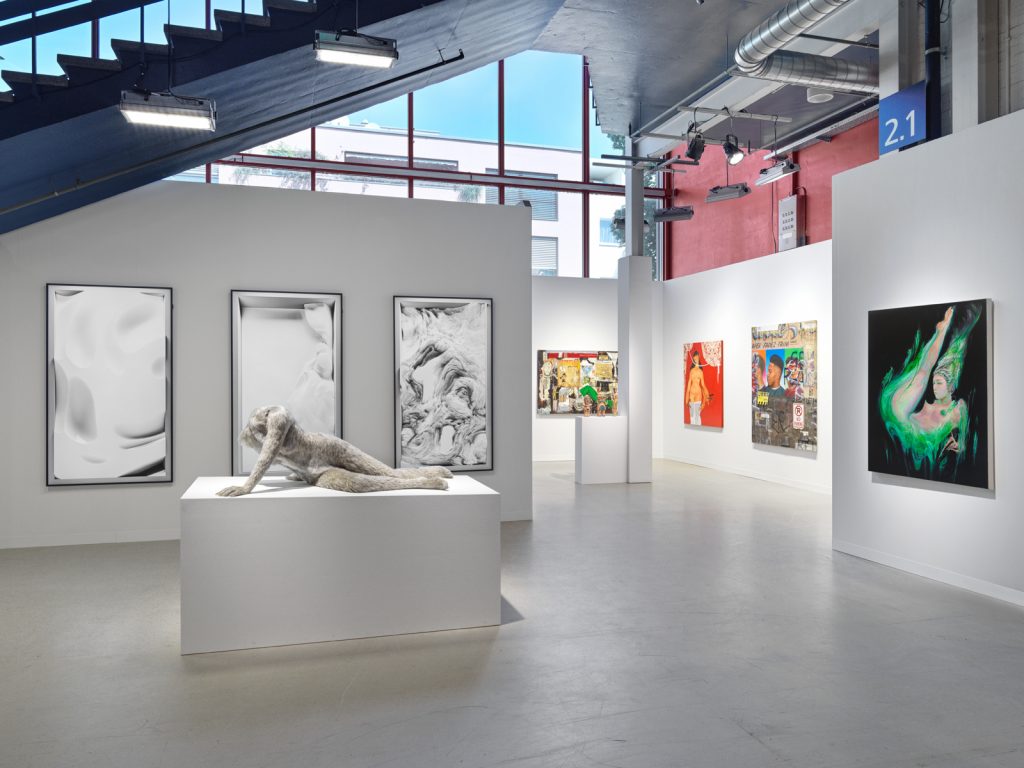
Refic Anadolu's AI Data Paintings is one of the projects involving artificial intelligence. NFT-based industries were few and far between. (Installation view of Jeffrey Deitch's stand with neural painting by Refik Anatoli. Photo: Stefan Altenberger.
In 2021, Kenny Schacher made his NFT-based artistic debut for Art Basel with a special project called "NFTism" at Galerie Nagel Draxler, which filled his stand with curious, confused and enthusiastic visitors. This year, he said he was not surprised by the sudden lack of crypto art at the exchange. "The market for cryptocurrencies has crashed, so nobody here wants to do anything about it," he said, sitting in the fair lobby with some friends. He reached out to show me his famous "NFT" tattoo, which he recently updated to add the word "POST."
"People here are so conservative that they want what their friends have," Schachter said. "Industry fingers are up and the wind is blowing away from NFTs, especially with the SEC crackdown." (U.S. regulators are currently knocking on the doors of major cryptocurrencies like Coinbase and Binance.) Last fall, Art Basel Miami Beach experienced a decline in interest, he said. No changes from December to June. "As things calm down, the art world will come back."
Galleries that quickly filled the crypto space took a break this year, including galleries Nagel Draxler and Pace, the latter of which exhibited Jeff Koons' first NFT project , Jeff Koons: Moon Phases , last year. Both now continue to work in the crypto space, but in areas that extend beyond Messeplatz (Pace is still active online, and Nagel Draxler has a dedicated gallery in Berlin called CryptoKiosk, with all sorts of blockchain-related work). The stands at Art Basel are dominated by paintings, sculptures and classics from art history.
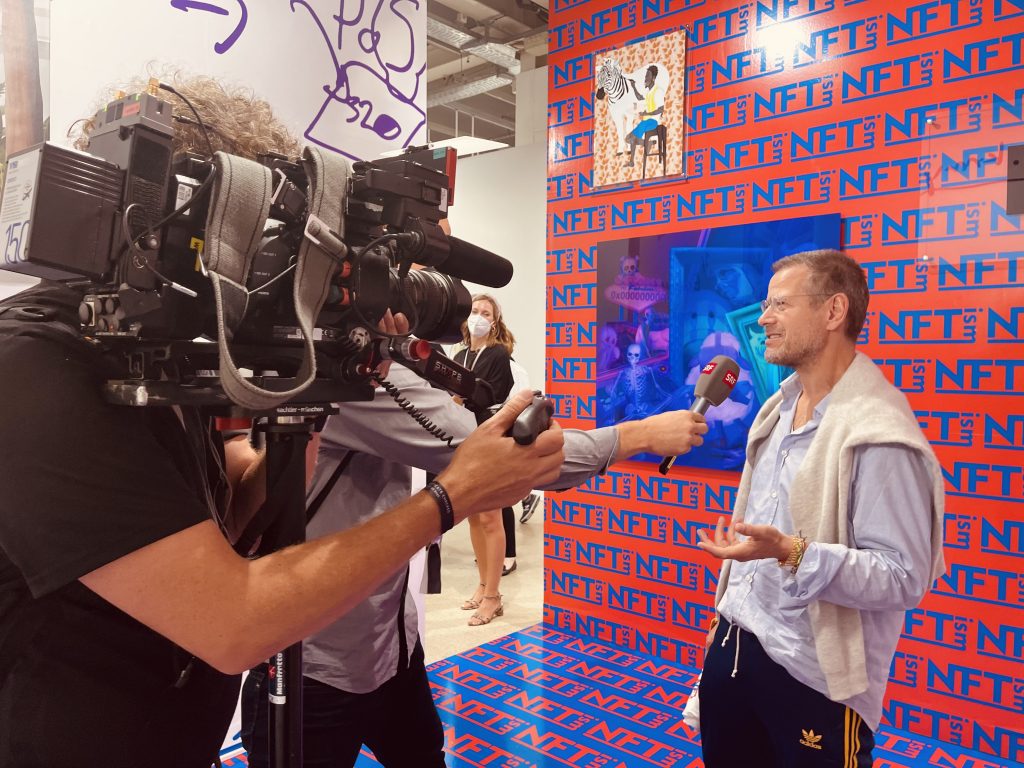
Kenny Schachter at the Crypto Kiosk of the Nagel Draxler Gallery in Basel in 2021.
A spokesperson for Pace said they may consider showing some pieces at Art Basel later in the week, but that depends on changes to the booth once the sale closes.
However, if you really look, NFT jobs exist in a number of places. Simon Denny, long involved with new technologies in his practice, had perhaps the only NFT-based work at a major art show, and he intended to mix it up: his paintings at the Petzel, his new Metaverse series Landscapes, fragmentary images of one of his canvases On the surface it appears as a traditional work. It was next to a large painting by Martin Kippenberger worth 1.65 million euros.
Denny's work only reveals its full meaning when you see that it has QR codes next to it, one of which shows you a private property in the metaverse that represents the work. Danny has created quite a bit of virtual real estate, such as NFTs that come with a drawing, which raises questions about ownership in virtual space. Again, the piece cleverly borrows from landscape painting and classical conceptualism to make the point: crypto-art is designed to let art (literally) induce history.
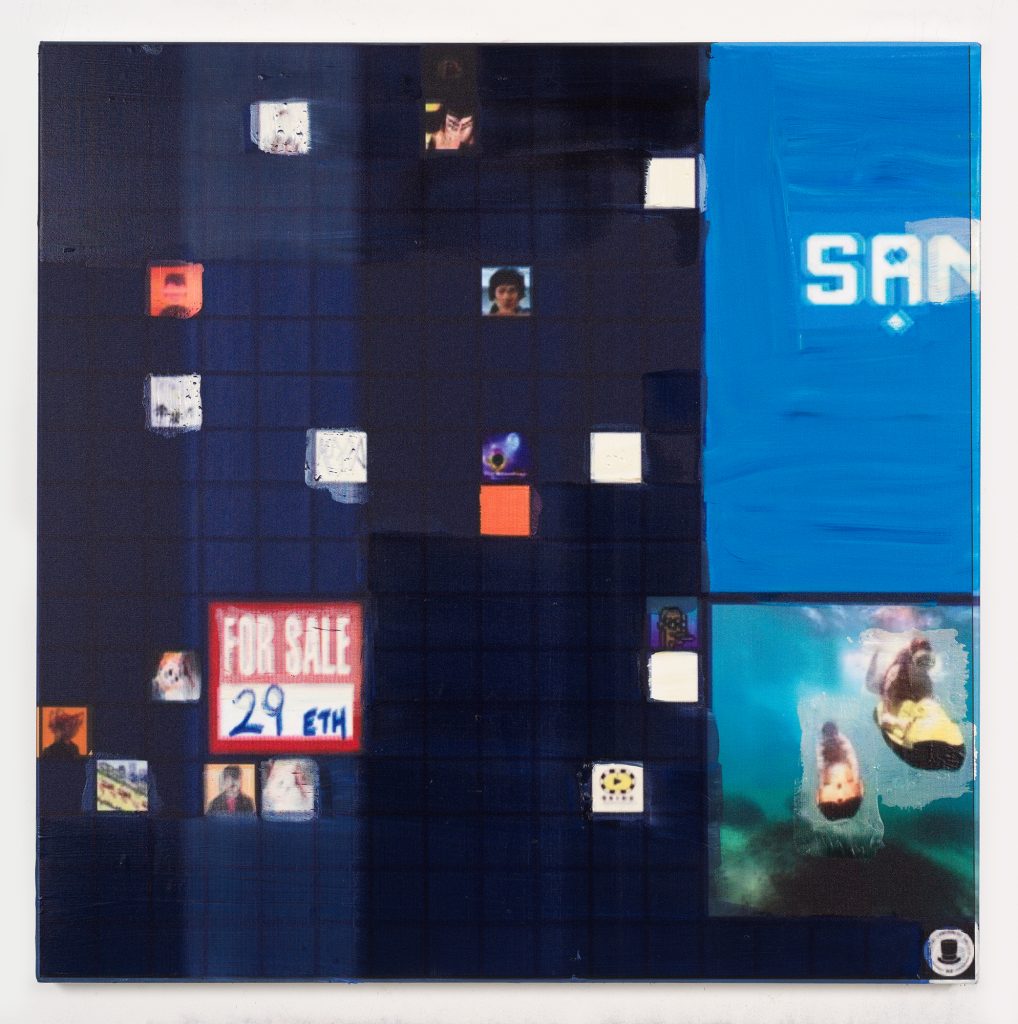
Simon Denny's Metaverse Landscape 8: Sandbox Land (-196, 23) (2023). Oil on Canvas, UV Print, Ethereum Paper Wallet, Dynamic ERC-721 NFT. Photo: Nick Ash. Courtesy: Artist
“People are looking for things that are reliable in terms of value, and cryptocurrencies and NFTs are pretty unreliable,” Schilber told me. “This project draws the public here because it is essentially a painting and it is about the history of art. You don't have to be a cryptocurrency expert to buy it either." Note: A slide with a crypto wallet is embedded in the back of the painting so that anyone who buys this piece can access NFTs without having to learn how to make one sounds like a winning strategy: valued at €30,000, Danny's work was booked at 4pm on the day of the preview.
Meanwhile, galleries have moved on to use technology for real, concrete business strategies. Now an official partner of Art Basel, Arcual is ensconced in the third-floor collector's lounge alongside champagne, lectures and art presentations. The company uses blockchain technology to create an ownership chain that benefits both artists and distributors in hopes of changing the way artists do business in the marketplace. They generate NFTs for all artifacts.
"I strongly believe in what blockchain can bring to the industry, but I have always been skeptical of the projections we see," says Bernadine Broker Wieder of Archual. "We want to focus on art again." He points out that this current moment in cryptocurrency is less wild than 2021 when the NFT-based industry took off. "We're following some of the standards set by the rise of NFT, but we've helped it evolve so that it works very well in the industrial world in the same way that it does in the industrial world."
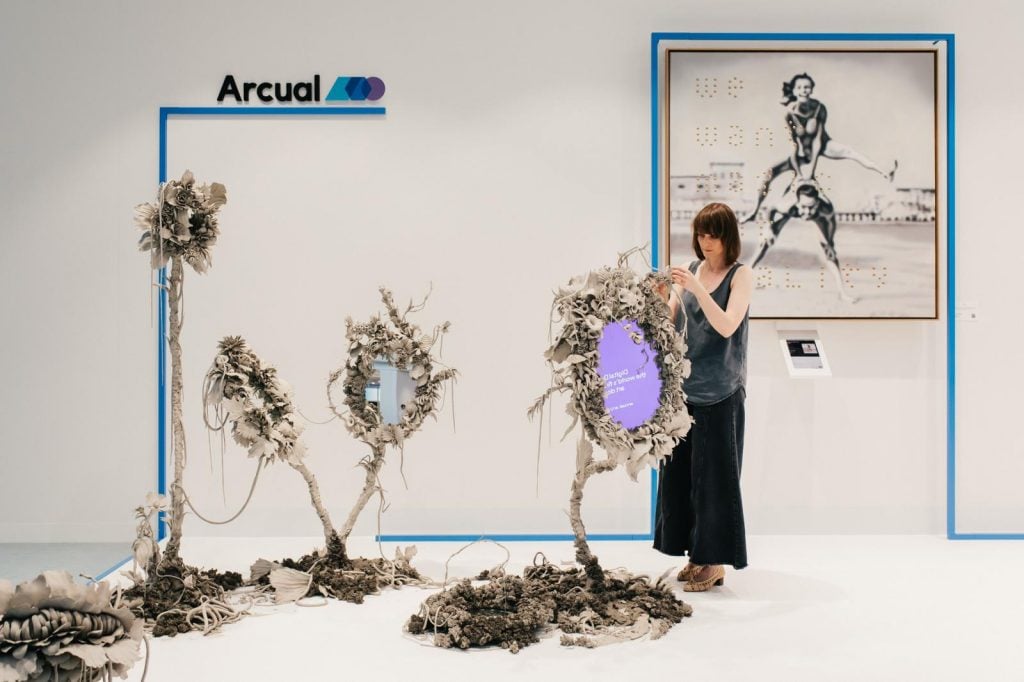
Phoebe Cummings at the archive booth, Art Basel in Basel, 2023, photo by Gloria Soverini Photography.
The hot topic of technology has naturally shifted to artificial intelligence. There is widespread public concern in this area, which is why the industry felt a renewed need to be involved. The subject of a major exhibition at MoMA earlier this year, Rafik Anadolu's digital paintings were the focus of Jeffrey Deitch's booth, although the dealer emphasized how easily they could be understood in conventional art terms. .
"Our market is traditional," Jeffrey Deitch said when asked about collectors' appetite for digital art. "People buy these works as 'living paintings'," he says, referring to the current series title, but there were always groups of celebrities in front of him.
In the Unlimited portal, BMW's annual Art Car took a high-tech turn this year for artists who don't normally work in the digital space. Bold abstract geometric paintings by South African artist Esther Mahlangu were among the spectacular generative artworks on display.
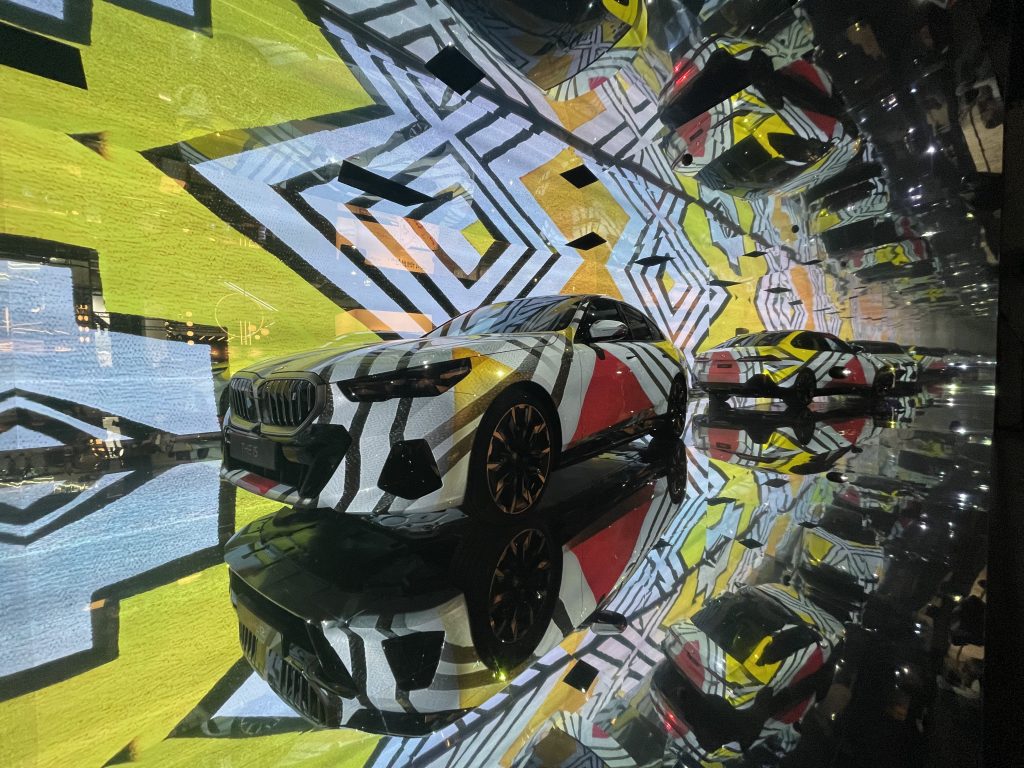
Electric Artificial Intelligence Canvas at Art Basel 2023. Installation inspired by the new BMW i5. Esther Mahlangu, 2023. © BMW AG
The Unlimited section of the fair also features the work of Croatian artist Tomo Savic-Geka. Basically, there's a big screen that explains the basics of what you're looking at; The real show was at the fairgrounds, and even trying to fit into the tech-based industrial environment and talking to people using familiar symbols could have been a joke.
For the work, the selected lights around Art Basel were designed to change intensity at certain times. These changes were driven by an algorithm driven by data based on randomly selected art news articles and analyzed in the latest Art Market: An Art Basel and UBS report.
Various jobs are advertised daily on the project's website, as well as on giant screens located at the stalls of the Unlimited and Frank Elbaz galleries. The public is invited to tour these spaces and observe their surroundings, thus becoming part of the show.
It's a fun job. But even Elbaz representatives point out that the learning curve is often steep for digitally involved industries. "It's an art form that collectors don't know about, but it's also ephemeral," said a spokesman for the Paris-based gallery. "You really have to go to the collectors and talk to them about the work, but also concept art in general." (There are two versions for sale, at €70,000 and €95,000).
For now there seems to be a general emphasis on items like paintings. Perhaps the recent cryptocurrency scene has dampened the appetite not just for crypto art, but for more adventurous forms of tech art in general. As markets become more optimistic, perhaps more work like Savić-Gecan's data-driven environmental work, which he sees as relevant to changes in society as a whole, will more clearly return to the sector. discrete plan
When it comes to crypto, many people are still betting on its return. “NFTs are revolutionary,” Schachter said. "It's here to stay. Let the dust settle."
Follow Artnet news on Facebook:
Want to keep up with the art world? Sign up for our newsletter to receive the latest news, eye-opening interviews and sharp criticism that moves the conversation forward.

